Lockheed SR-71 (YF-12,A-11) "Blackbird"
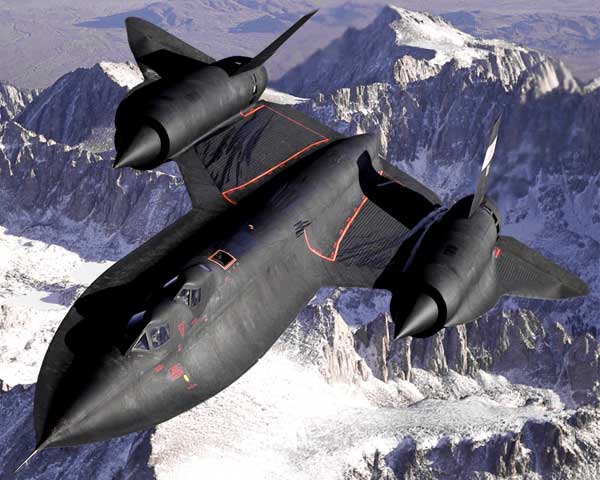
The Lockheed SR-71 Blackbird is the most spectacular performer ever to leave the ground under its own power and spread wings. Thirty years after entering service, the Blackbird is aloft again after a premature retirement. lt is still the world's fastest and highest-flying operational aircraft.
Lockheed YF-12A (SR-71,A-11)
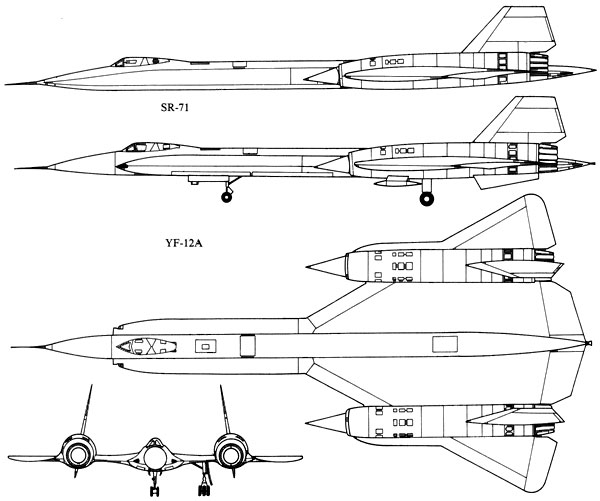
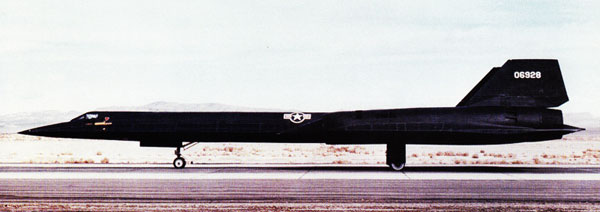
On December 22, 1964, a huge lance-like shape parted company with its shadow on a desert air strip in Nevada as the sky became the recipient of the most awesome fighting machine yet devised. Its proportions made it the largest fighter type to fly, and its weight exceeded by a great margin that of any other interceptor. For its first flight, the aircraft bore the designation A-11, assigned by Lockheed, but the official Air Force designation YF-12A has since been applied, and again changed to SR-71.
The design of the YF-12A was initiated when Lockheed won a competition for an advanced interceptor and received a contract in 1960. The requirements specified a cruise speed greater than Mach 3 and a sustained altitude higher than 80,000 feet. A plane capable of this performance had to be designed from the beginning. It was bound to be different, and it is.
Not long after the YF-12's began flying, airline pilots reported seeing strange-shaped aircraft flashing past them. Since the new interceptor had been conceived and built under the utmost secrecy, it is easy to imagine what these pilots thought they saw. Its extraordinary performance and unorthodox shape certainly would tend to place it in the category with other unidentified flying vehicles. But the YF-12A is very tangible indeed.
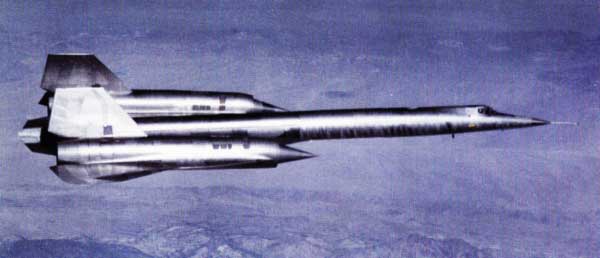 |
The first A-11 as it appeared in a bare metal finish. |
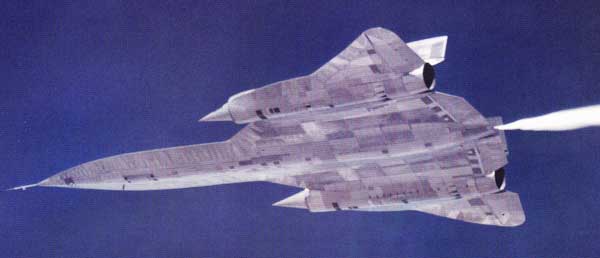 |
The YF-12A is virtually a titanium shell around a huge fuel tank. It is approximately 101 feet long, supported by a 1,800 square foot wing spanning 55 feet 7 inches. The top of the canted rudders are 18 feet 6 inches from the ground. The empty weight of this immense fighter is near 60,000 pounds; its gross weight is more than 140,000 pounds. The sharp edge along the forward fuselage actually forms a forward lifting surface, as on a canard, thereby letting the fuselage itself generate aerodynamic lift. In- side this widened area are the bays which can house four Hughes AIM-47 A Falcon AAM's. These missiles were originally in- tended to arm the cancelled XF-108 Rapier. The leading edge of the forward lifting plane contains infrared sensors, and the needle-like nose houses the necessary radar and fire control systems. The highly responsive radar used in the YF-12A has a detection range of nearly 800 miles, or in terms of the YF-12's speed, about 20 minutes travel time.
Two YF-12A's established no less than twelve official world records on May 1st, 1965. Among these were the absolute speed of 2,070.102 mph and sustained altitude of 80,257.86 feet At Mach 3 speeds, the heat generated by the YF-12A can reach 1,100 degrees F. To reduce this high temperature, the planes are coated with 60 pounds of a special black paint which helps dissipate the heat. But despite this, Parts of the airplane still remain extremely hot for a while after the plane has landed. This great heat also has an effect on the airframe itself. As heated metal expands, it can distort the precise aerodynamic shapes of a Mach 3 aircraft, An ingenious method of overcoming this was the use of corrugations in the wing surfaces. These ripples allow the flexing of the metal skin without impairing the flying characteristics.
High performance flight, of the type undertaken by the YF-12A, requires a powerplant of phenomenal output. The huge 32,500 lb. Pratt & Whitney J58 engines were made specifically for the big fighter; they are equally as advanced in concept as well as performance. To attain the necessary Mach 3 cruise speed, the afterburner has to be in continuous operation. To achieve this, Pratt & Whitney designed the unit to function as a ramjet, reminiscent of the engine devised for the XF-103 interceptor. A complex sensing mechanism positions the inlet cone on each nacelle for the most efficient air flow to the engines. The fuel used is JP-7, a hydrocarbon-type developed for the YF-12A. Eighty thousand pounds of fuel are carried in five tanks.
At Mach 3, the YF-12A must make a turn of 180 miles radius to reverse its direction. In the high speed regime, most of the flight operations are performed by automatic systems. Because the plane was designed expressly for extremely high speeds, it is unusual to find that the YF-12A has very conventional low-speed characteristics. Approach speed is approximately 200 mph; touch-down is 172 mph. The SR-71 is the production version of the A-11. Its primary duty is reconnaissance, and it differs mainly in electronic gear. The SR-71, nicknamed "Blackbird," has been refined for greater aerodynamic efficiency. The foreplane extends in an unbroken line to the nose, and the empennage protrudes six feet behind the delta wing. This increased area permits the elimination of the large retractable and two fixed ventral fins used on the YF- 12A for high-speed stability.
Total quantities of the YF-12A have not been officially disclosed, but at least three planes were built as interceptors. SR-71 production has exceeded 21 units; but here again, the actual number is classified. In recognition of the advanced engineering involved in the development of the YF-12A/SR-71, the radical "Blackbird" became the recipient of the Collier Trophy in 1964.
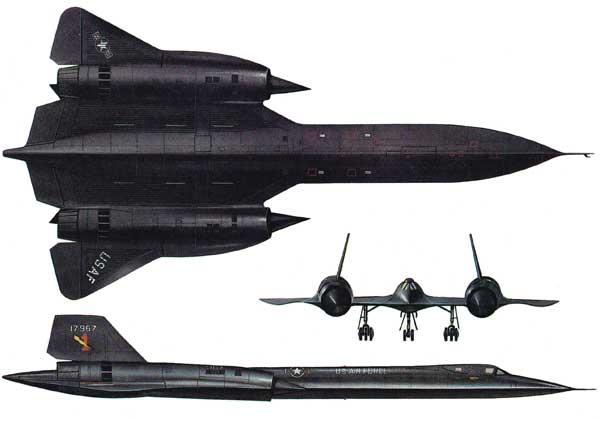
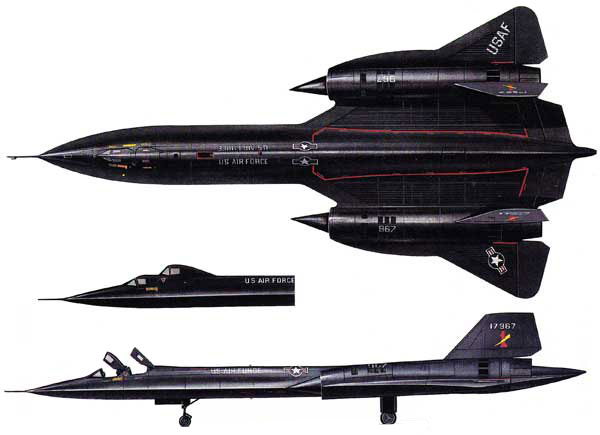
Lockheed SR-71 (Y-12,A-11)
Kelly Johnson's masterpiece, the culmination of 20 years devoted to the design of outstanding planes, is still treated to a great extent as classified material. The A-12/YF-I2AISR-71, better known under its name of Blackbird was Lockheed's response to a design competition announced by the USAF in 1960 to fill its requirement for a strategic reconnaissance airplane which could fly at Mach 3 and operate at altitudes above 80,000ft. It appears that the specification had been drawn up at the CIA's behest, since the Agency wanted to be able to carry out photo reconnaissance missions over enemy territory by flying so fast and so high that no interceptor or missile could reach the spy plane.
Competing projects were submitted by General Dynamics, Boeing and North American but once more, Kelly Johnson had offered just what the customer wanted. This was not so surprising since Johnson -had collaborated with the USAF since 1955 with a view to developing an exceptionally high performance high-level plane. In 1954 a British engineer who had emigrated to California, Randolph Samuel Rae, had impressed the USAF with his idea for a turbojet fueled by liquid hydrogen and oxygen, a fuel which was ideally suited for use in the upper-layers of the earth's atmosphere.
Garrett Corporation of Los Angeles had been asked to design and build the engine and Johnson was asked to design an aircraft around it. With his team from the "Skunk Works" (the building in which they worked had a black and white lobby and tire team was as wary of inquisitive intruders as the animal of that name), he designed the Model CL-325 in 1956-57, powered by the Garrett Rex III, and the Model CL-400 which was to have Pratt & Whitney's liquid hydrogen jet engines. Neither of these propulsion units ever materialized and nor consequently, did the airplanes but it was certainly logical that the USAF should entrust the new project to a designer who had already covered much of the ground.
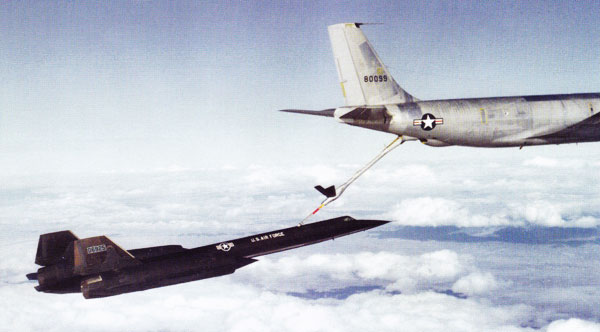
On January 30, 1960 an order was placed with Lockheed for 12 air- craft, designated A-12, a classification which was not consistent with the USAF system nor with the company's method. Some assert that the CIA supplied the designation, some others that Kelly Johnson admitted to having chosen it himself in 1981, as he had decided to choose the 12th version of a design he had originally called A-11.
On April 26 1962, Louis Schalk took off from a secret base called "The Ranch" at Indian Spring, Nevada in the first A-12, powered by two Pratt & Whitney turbojets delivering 60 percent less thrust than the J58 engines chosen by Johnson, which were not yet ready. Tests were encouraging but a great deal hinged on how the A-12s would perform when powered by the correct engine: only then would it become clear whether the tremendous problems generated by the plane's tri-sonic speed had been mastered and whether the plane's aerodynamics and construction materials (93 percent of which was a titanium alloy) had overcome the obstacle posed by kinetic heating: at Mach 3 some sections of the plane had to be able to withstand temperatures of approximately 3,000 F. The test flights proved that Kelly and his 75-strong engineering team had got it right.
These single-seat A-12s were immediately put into service by the CIA under a blanket of total secrecy; two of them were modified so that they could launch a small radio-controlled aircraft, designated D-21, packed with photographic equipment which could spy out enemy territory without running the risk of meeting the same fate as Gary Powers' U-2 plane.
Meanwhile Lockheed put forwards the suggestion that four A-12s could be modified as two-seat interceptors as a possible replacement for the Convair F-106 (q.v.). The first YF-12A, as the USAF had designated the plane, had its maiden flight on August 7, 1963 and it appears that it differed little from the A-12. Most of the fuselage was occupied by fuel tanks, and the wing was attached to the fuselage by an aerodynamic platform called LEX (Leading Edge Extension) following the wing-body integration method. The razor sharp leading-edge extensions or lifting "chines" began level with the cockpit. The irregular delta shape wings, with four trailing- edge elevons, were swept at an angle of 60 degrees, the leading-edge being interrupted outboard of mid-wing by the engine nacelles; the vertical tailplanes were mounted on top of the engine nacelles, tilted in- wards at an angle of l5 degrees; on the underside of the nacelles were two strakes, smaller that the retractable center ventral strake.
The YF-I2A was covered by a special black thermally emissive paint which also interfered with enemy detection radar. The flight controls were computerized; this was the first aircraft in which an inertial navigation system had been installed. The electronics included an AN-ASG-I8 Doppler system, search and fire-control radar with a range of 500mi and an infra-red display; the armament consisted of four Hughes AIM-47A Falcon missiles.

The existence of the YF1I2A was publicly acknowledged by President Lyndon B. Johnson himself in February 1964 when the four completed aircraft had already been delivered to 4786th Test Squadron for trials and on May l, 1965 the Commander of that squadron, Col. Robert L. "Fox" Stephens, flying with Lt. Col. Daniel Andre, set a new speed record of 2,070.102mph at 80,258ft. This record has yet to be beaten. Although it was patently obvious that the YF-12A was a formidable plane, it was also very, very expensive and in November 1967 the USAF decided that it would be impossible to persuade Congress to vote the necessary funds for the plane to go into series production.
The USAF and NASA continued with the YF-12A evaluating flights for many years, the last of these planes having been taken out of service as recently as 1979. The strategic reconnaissance version did not fall victim to financial constraints, however, and in December 1962, 32 were ordered and designated SR-71. These planes were of greater overall length than the YF-12A, they were also heavier but had the same aerodynamic platform skirting the fuselage extending as far as the nose. The exact performance figures for these aircraft are still secret; SR-71s are still in service with 9th Strategic Reconnaissance Wing (formerly 4200th Wing) at various unspecified strategic bases. The A-12, the YF-12 and the SR-71, three versions of the same basic design, qualify as some of the most amazing aircraft in the history of aviation. In recognition of his services to American aviation, Kelly Johnson became the first person ever to be awarded the Robert J. Collier Trophy twice (which he received for the second time in 1964), an honor bestowed for outstanding achievement in aeronautical progress.
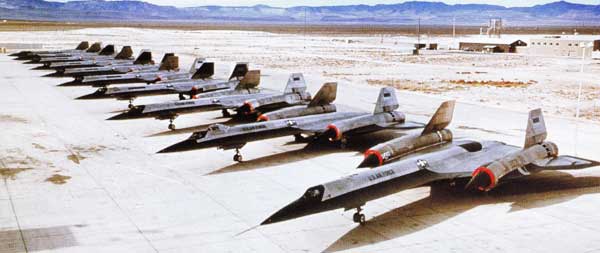
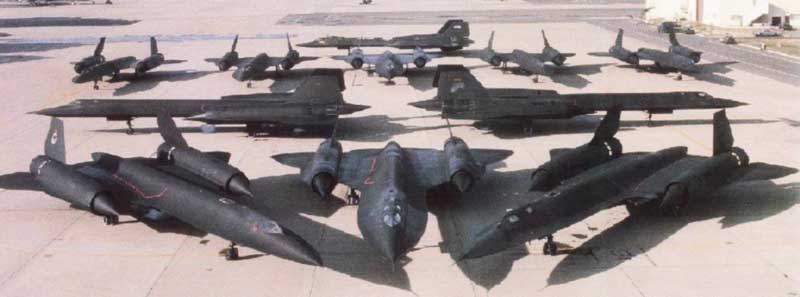
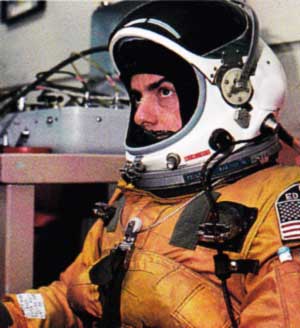 |
SR-71s operate at the extreme edge of
the Earth's atmosphere, and their crews
need to wear space suits to have a chance
of surviving in the event of an emergency. |
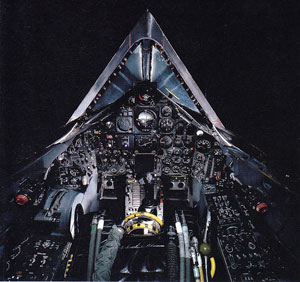 |
Lockheed SR-71 Cockpit. |
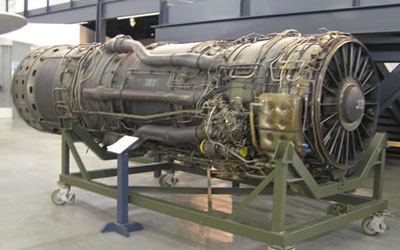 |
Lockheed SR-71 Engine a P&W J58-1 continuous-bleed
afterburning turbojet |
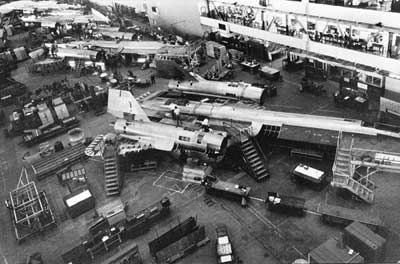 |
 |
Lockheed SR-71 Blackbird Factory. |
|
Specifications for the Lockheed SR-71
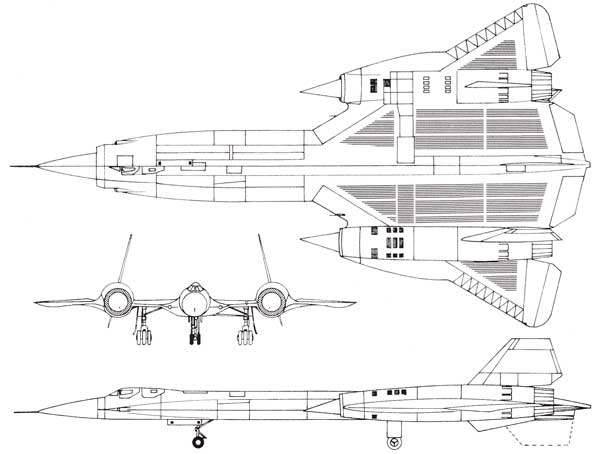 |
Crew: 2 Payload: 3,500 lb of sensors Length: 107 ft 5 in Wingspan: 55 ft 7 in Height: 18 ft 6 in Wing area: 1,800 ft sq Empty weight: 67,500 lb Loaded weight: 170,000 lb Max takeoff weight: 172,000 lb Powerplant: 2× Pratt & Whitney J58-1 continuous-bleed afterburning turbojets, 32,500 lbf each Wheel track: 16 ft 8 in Wheel base: 37 ft 10 in Aspect ratio: 1.7 Performance Maximum speed: Mach 3.2+ (2,200+ mph) at 80,000 ft Range: 2,900 nmi Ferry range: 3,682 mi Service ceiling: 85,000 ft Rate of climb: 11,810 ft/min Wing loading: 94 lb/ft² Thrust/weight: 0.382 |
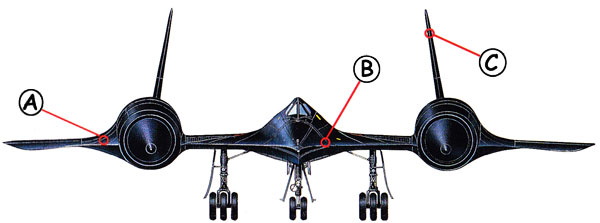 |
||
| A: The black paint is highly sophisticated and specially formulated to radiate excess heat while at the same time disrupting incoming radar energy. At operating temperatures and altitudes, it changes color to blue. | B: To withstand the intense friction-generated heat at Mach 3, over 90 percent of the Blackbird's airframe is made of titanium. | C: The vertical tails are the only large, flat surfaces on the Blackbird. They are canted slightly inboard in an attempt to deflect the large radar returns they would produce. |
 |
|||
| A: The nose contains reconnaissance sensors. The entire unit is detachable so that different sensor combinations can quickly be fitted. | B: The Blackbird's tires are filled with nitrogen and impregnated with powdered aluminum to enable them to withstand heat. | C: There are four compartments in the fuselage, which can house panoramic, long-range and infrared cameras, electronic intelligence sensors and side-looking radars. | D: The two huge Pratt & Whitney J58-1 continuous-bleed afterburning turbojets engines operate as ordinary jets at low speeds, switching to become ramjets at speeds above 2,000 m.p.h. |
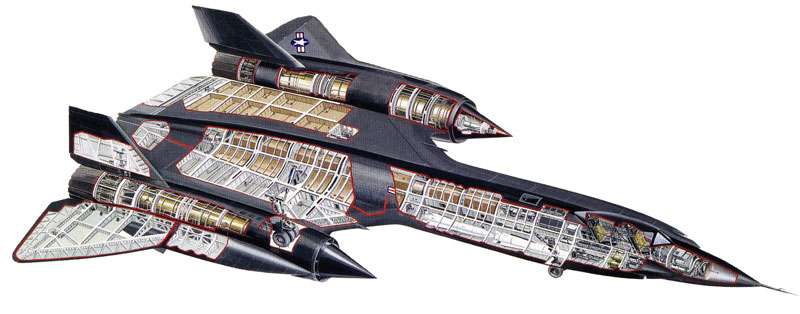 |
| Full size 8.5 x 11 PDF included in your MyModels folder for Free! |
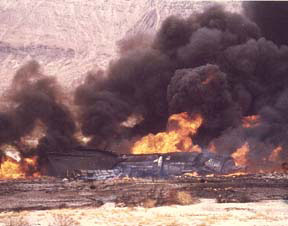 |
There are lots of sites dedicated to the SR-71 and to their crashes here's one that shares with you a lot of information about the crashes and the men that served. More |

